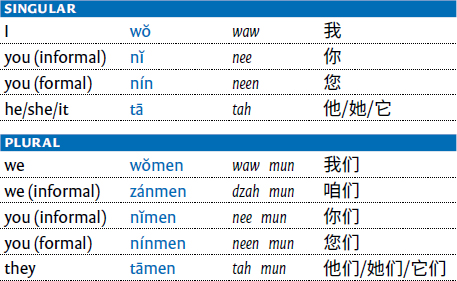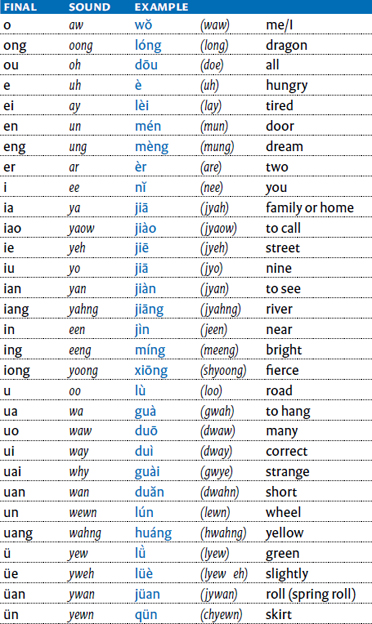Grammar in Five Minutes
Pronouns
Here are some of the most important words you’ll need to know in Chinese: the personal pronouns.

Note: Both third person singular and plural are pronounced the same. It is only by looking at the Chinese character that one can determine whether “ta” means “he, she, or it.”
Politeness and Formality
Chinese speakers distinguish between formal and informal forms of “you” when addressing older people or those in positions of authority. To be on the safe side, use “nĭ” (nee) only when speaking with close friends or with children. Use “nín” (neen) when addressing anyone else, especially if they’re older than you.
Gender and Tense
Students of Chinese are blessed with the lack of gender and tense distinctions. Pronouns remain the same, regardless of gender. Third person pronouns “he,” “she,” and “it” are all pronounced the same: tā (tah). They are distinguishable only by the written word, which will have either a male, female, or animal component to the character. In spoken Chinese, however, since third person pronouns are all pronounced the same, they are distinguishable only by context.
Pinyin Sounds
Pinyin (literally “to spell the way it sounds”), China’s official Romanization system since 1979, represents “initial” and “final” sounds of Chinese words, which may be counterintuitive for the average new speaker of Chinese when attempting to pronounce street signs or bathroom signs in China.
As a caveat, one should keep in mind that the examples given below represent only one out of many possible meanings for a word with that sound, since the same word said in a different tone will mean something else.
Initials
Of the 23 initial sounds in Mandarin—those that come at the beginning of a word and are always composed of consonants—only five are unique enough to the native speaker of English to require their own list of pronunciation below.

Finals
There are only six vowel sounds in Mandarin: a, o, e, i, u, and ǚ. However, these combine to create 36 unique final sounds.

Chinese is a tonal language, regardless of which of the hundreds of dialects throughout the country one is speaking. Due to the great number of homophones, tones are the key to understanding the meaning of what is being said. Even so, any given syllable with a specific tone can also often have more than one meaning. Ultimately, it is only by looking at the written character that the meaning may be deduced. With spoken Chinese, meanings are largely gleaned from the context of what is being said.
Mandarin has four tones:

Most Common Verbs

Interrogative Pronouns
The following are basic “question words” in Chinese:

